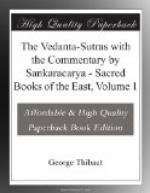the consciousness of their individual character.[230]
This undeveloped principle is sometimes denoted by
the term aka/s/a, ether; so, for instance, in the
passage, ’In that Imperishable then, O Gargi,
the ether is woven like warp and woof’ (B/ri/.
Up. III, 8, 11). Sometimes, again, it is
denoted by the term akshara, the Imperishable; so,
for instance (Mu. Up. II, 1, 2), ‘Higher,
than the high Imperishable.’ Sometimes it
is spoken of as Maya, illusion; so, for instance (Sve.
Up. IV, 10), ’Know then Prak/ri/ti is Maya,
and the great Lord he who is affected with Maya.’
For Maya is properly called undeveloped or non-manifested
since it cannot be defined either as that which is
or that which is not.—The statement of
the Ka/th/aka that ’the Undeveloped is beyond
the Great one’ is based on the fact of the Great
one originating from the Undeveloped, if the Great
one be the intellect of Hira/n/yagarbha. If,
on the other hand, we understand by the Great one the
individual soul, the statement is founded on the fact
of the existence of the individual soul depending
on the Undeveloped, i.e. Nescience.
For the continued existence of the individual soul
as such is altogether owing to the relation in which
it stands to Nescience. The quality of being beyond
the Great one which in the first place belongs to the
Undeveloped, i.e. Nescience, is attributed
to the body which is the product of Nescience, the
cause and the effect being considered as identical.
Although the senses, &c. are no less products of Nescience,
the term ’the Undeveloped’ here refers
to the body only, the senses, &c. having already been
specially mentioned by their individual names, and
the body alone being left.—Other interpreters
of the two last Sutras give a somewhat different explanation[231].—There
are, they say, two kinds of body, the gross one and
the subtle one. The gross body is the one which
is perceived; the nature of the subtle one will be
explained later on. (Ved. Su. III,
1, 1.) Both these bodies together were in the simile
compared to the chariot; but here (in the passage under
discussion) only the subtle body is referred to as
the Undeveloped, since the subtle body only is capable
of being denoted by that term. And as the soul’s
passing through bondage and release depends on the
subtle body, the latter is said to be beyond the soul,
like the things (arthavat), i.e. just as the
objects are said to be beyond the senses because the
activity of the latter depends on the objects.—But
how—we ask interpreters—is it
possible that the word ‘Undeveloped’ should
refer to the subtle body only, while, according to
your opinion, both bodies had in the simile been represented
as a chariot, and so equally constitute part of the
topic of the chapter, and equally remain (to be mentioned
in the passage under discussion)?—If you
should rejoin that you are authorised to settle the
meaning of what the text actually mentions, but not
to find fault with what is not mentioned, and that




